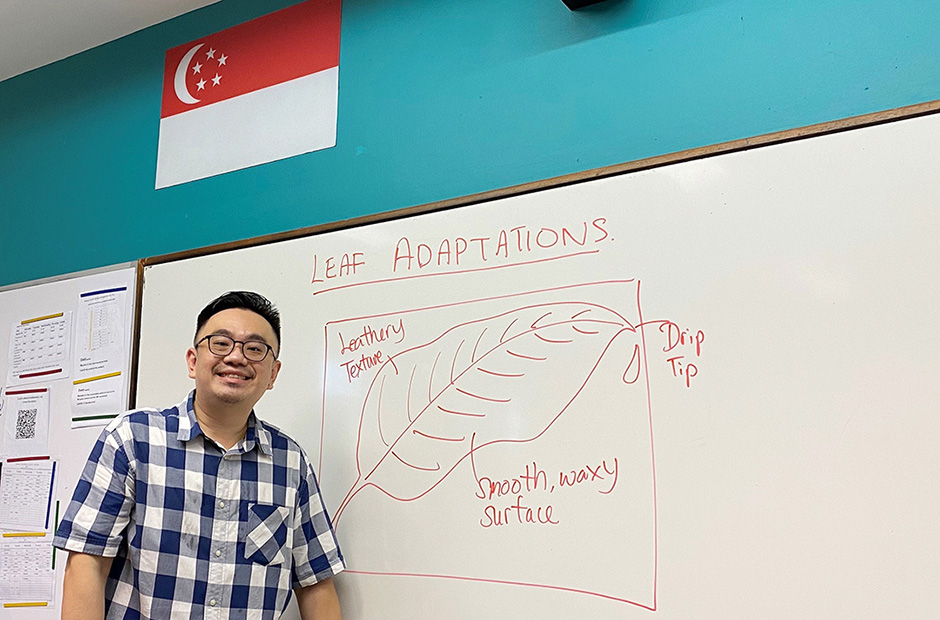Ms Asrina bte Abdul Samad, Institute of Technical Education, President’s Award For Teachers 2017 Recipient
Asrina bte Abdul Samad would often shift tables and chairs around for her Mechatronics lessons at the old ITE Tampines campus. She wanted her students to engage in group discussions and give presentations, but the classrooms simply were not set up for that.
When the College moved to its present site at Ang Mo Kio, the Principal offered resources to each of the schools for them to create their own innovative learning spaces. Asrina and a colleague jumped at the opportunity to create the classroom of their dreams from the ground up.
The result: the jumbo-sized Innovative Lab at the School of Engineering or iLab@SEG, equipped with interactive walls and augmented-reality applications, but little furniture. What few tables there are can be written on, and quickly put aside so students can sit or relax on the carpeted floor to continue their discussions.
Augmented-reality markers and 3D videos? All the better for engaging Asrina’s millennial students, who are all “digital natives”, having used IT devices from an early age.
Large, carpeted spaces? That’s because she observed that students prefer to study at the airport and other open, informal spaces.
Walls and tables that can be written on? That’s to help students who have difficulty retaining information. “They remember concepts better when they are free to represent them graphically,” Asrina explains.
That she would have thought of all this is no surprise. After all, she completed a Masters programme in Instructional Design and Technology at NTU, bagging an academic medal in the process.
For Teachers as Much as for Students
The iLab also plays an important role for teachers. Asrina uses it to help her colleagues sharpen their teaching methods.
She first observes their classes, then discusses how to redesign their lessons to be more student-centric.
Finally, she co-teaches with them in the iLab. Cameras record them in action, and Asrina reviews snippets of the footage with them to find areas for improvement. The co-teaching continues until her colleagues are comfortable enough to run the revamped lessons on their own.
Asrina has also used the lab to bring colleagues round to the idea of embracing technology while teaching. Some were initially resistant, being used to conventional classrooms with no internet connectivity, but they eventually caught on.
The success of iLab has made it a showpiece of ITE’s student-centred pedagogy. It has attracted the interest of overseas vocational training teachers from as far as Bangladesh, China, Canada and Germany.
Asrina herself is in demand as a classroom designer. She was a consultant to ITE College West’s project to upgrade the training facilities for its Automotive Engineering course. At ITE College Central, she was part of a team behind RoboGames@SEG, a “hip” learning centre to promote Mechanical and Mechatronics Engineering courses.
Teaching Still Comes First
It’s not just smart rooms, though. Asrina believes that teaching has to be done well, wherever it’s done.
Her recent appointment as Master Mentor – one of only six in the whole of ITE – puts her in a good position to help her colleagues, regardless of their discipline. She is currently with ITE Academy, and is happy to teach teachers there, because she knows she can reach even more students through them.
They, in return, help her to keep abreast of the latest technologies, as many of them are experienced professionals previously working in fields such as robotics and hydraulics.
She gives the same attention to teachers from abroad, too. Bangladeshi educators who attended some of her courses at ITE in early 2017 continue to send her their lesson plans for her to comment on, and she gladly obliges.
“Their training doesn’t stop. It’s an ongoing process,” she explains. Knowing that she has contributed to making them better, more approachable teachers who are able to deliver more engaging lessons is reward enough for her, she says.
Her latest project is ITE’s push for Discipline Specific Pedagogy, which involves finding the most appropriate methods to equip students with the skills and attitudes for the professions they are working towards.
For instance, aeronautics relies largely on case studies, while mechatronics is often best taught by providing students with authentic tasks. Asrina was one of 17 ITE educators sent for a one-month attachment in a teacher-training college in Germany to build their expertise in this area.
At the end of the day, whether she is upgrading rooms or teachers, Asrina does everything for her students. “They are vulnerable. I want to develop them as unique individuals, give them life skills, handle their motivation and engage them,” she says.
“I strongly believe in three things. I believe in my students. I believe in giving them hope. I believe in giving them opportunities.”



.jpg)
.jpg)

